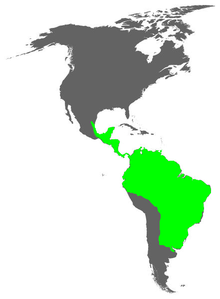Antbird
The antbirds are a large passerine bird family, the Thamnophilidae.[1] They are found in subtropical and tropical Central and South America, from Mexico to Argentina. There are more than 200 species called antshrikes, antwrens, antvireos, fire-eyes, bare-eyes and bushbirds.
| Antbirds | |
|---|---|

| |
| Bicolored antbird Gymnopithys leucaspis | |
| Scientific classification | |
| Domain: | Eukaryota |
| Kingdom: | Animalia |
| Phylum: | Chordata |
| Class: | Aves |
| Order: | Passeriformes |
| Parvorder: | Thamnophilida |
| Family: | Thamnophilidae Swainson, 1824 |
| Diversity | |
| Some 62 genera, over 230 species | |

| |
| Global range (in green) | |
They are related to the antthrushes and antpittas (family Formicariidae), the tapaculos, the gnateaters and the ovenbirds.[2] Despite some species' common names, this family is not closely related to the wrens, vireos or shrikes.
Antbirds are generally small birds with rounded wings and strong legs. They have mostly dull grey, white, brown and rufous plumage. The two sexes have somewhat different pattern and colouring. Some species communicate warnings to rivals by exposing white feather patches on their backs or shoulders. Most have heavy bills, which in many species are hooked at the tip.
Most species live in forests, although a few are found in other habitats. They eat mostly insects and other arthropods. Small vertebrates are occasionally taken. Most species feed in the understory and midstory of the forest, although a few feed in the canopy and a few on the ground.
About eighteen species specialise in following columns of army ants to eat the small invertebrates flushed out by the ants.[3]
Antbirds are monogamous, mate for life, and defend territories. They usually lay two eggs in a nest. Both parents share the tasks of incubating eggs and raising the nestlings. After fledging, each parent cares exclusively for one chick.
Thirty-eight species are threatened with extinction as a result of human activities. The main threat is habitat loss, which lets predators get at their nests more easily.
References
change- ↑ Zimmer K. & Isler M. 2003. Family Thamnophilidae (typical antbirds) pp. 459–531 in del Hoyo J; Elliot A. & Christie D. (eds) 2003. Handbook of the birds of the world, volume 8: Broadbills to Tapaculos. Lynx Edicions. ISBN 84-87334-50-4
- ↑ Irestedt M. et al 2004. Phylogenetic relationships of typical antbirds (Thamnophilidae) and test of incongruence based on Bayes factors. BMC Evol. Biol. 4: 23. [1]
- ↑ Willis E. and Oniki Y. 1978. Birds and army ants. Annual Review of Ecology and Systematics 9: 243–263. [2] Archived 2016-04-12 at the Wayback Machine